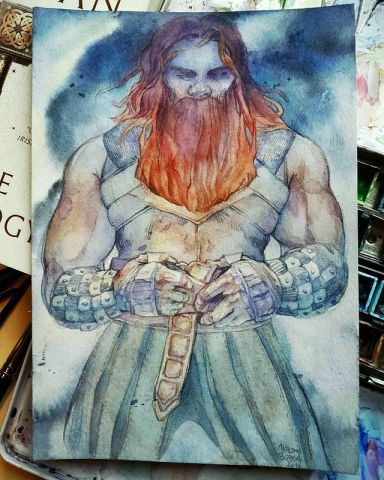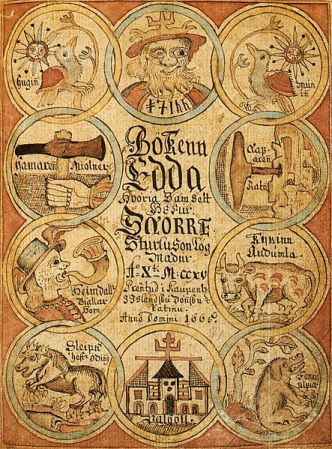Thor’s role as one of the most powerful gods in the Norse pantheon is vital in the ongoing battle between the gods and the giants. Among Thor’s many attributes, one artifact, in particular, stands out as a symbol of his immense power: Megingjord, the Megingjörð in Old Norse. This “power-belt” doubles Thor’s already formidable strength and plays a crucial role in his legendary adventures.
The Prose Edda, highlights Megingjord as one of Thor’s primary possessions, along with his hammer Mjölnir and iron gloves Járngreipr. Exploring the stories there I will try to provide a detailed overview of this intriguing artifact. Doubling Thor’s immense strength when worn, Megingjord symbolizes power and might for both Thor and the broader warrior ethos of the Viking Age.
Name and Etymology
As names go, the name of Thor’s belt is quite descriptive of its benefit when used. Megingjord is usually translated as “Belt of Strength”, or more plainly, power belt.
In Old Norse, it is written “Megingjörð.” This compound word consists of “meging,” which translates to “power” or “strength,” and “jörð,” meaning “belt” or “girdle.” The etymology of Megingjörð highlights its importance as a symbol of power and strength in Norse mythology.
How did Thor get his Belt of strength?
There is a great story about how Thor’s hammer Mjolnir was created by the two dwarves Sindri and Brokkr. However, little or nothing is said directly about how the Megingjord came into Thor’s possession.
Personally, I think it was a gift from the giantess Gridr as described in the poem Thórsdrápa found in Skáldskaparmál.
In the story, Loki gets captured by the jötun Geirröd. To gain his freedom he promises to lure Thor back there without his weapons, undoubtedly for Geirrödr to kill him.
Walking straight into Loki’s entrapment, Thor is later on his way to Jotunheim accompanied only by his servant Thjalfi. On their way there, they stop by the house of the giantess Gridr (Old Norse Gríðr) mother to Odin’s son Vidar. She warns that Geirrödr is an evil jötun intent on causing them harm.

To help Thor, she lends him her magical staff, the Gríðarvölr, her iron gloves and her power-belt. I think this is the first time Thor lays his hands on any iron gloves or belt of strength. Before this, I think he only had his hammer Mjolnir as an enchanted artifact.
Details from the Thórsdrápa Prose Description
In chapter 18 of the Skáldskaparmál Snorri describes these events in prose form.
“Finally, Geirrödr released Loki and demanded that he reveal his identity. Loki swore oaths to Geirrödr, promising to lure Thor into Geirrödr’s dwelling without his hammer Mjöllnir, belt of strength or his iron gauntlets in exchange for his life.
Thor went to spend the night with the giantess Grídr, who was the mother of Vídarr the Silent. She warned Thor that Geirrödr was a cunning giant who could not be trusted, and she lent him her Girdle of Might, iron gloves, and her staff, called Grídr’s Rod.”
It might seem presumptuous of me to disregard the fact that Snorri states that Thor left his iron gloves and power belt behind. However, the Prose Edda is littered with slight misunderstandings or statements that are contradictory to what is found in the much older stories of the Poetic Edda.
I am a huge believer in the idea that most often the simple explanation is the correct one. In Norse mythology, which has a great number of magical artifacts, all typically have a backstory. This is so for Thor’s hammer Mjolnir, Freyr’s flying boar Gullinbursti, Freyja’s necklace Brisingamen, Odin’s spear Gungnir and ring Dripnir and so on.
There should be a story about how Thor came to have the Belt of strength and the iron gloves. The Thórsdrápa is that story I believe and before it, Thor only had his hammer.
Why does Thor need the power belt?
Again, I think there is a misunderstanding among a lot of people that Thor needs the Megingjord in order to handle Mjolnir. Megingjord is said to increase, or maybe even double Thor’s strength. However, he is more than strong enough to wield Mjolnir without the benefit of the Belt of Strength. The Megingjord just increases his strength. This benefit is attested to in Gylfaginning ch 45
Old Norse: Hann spennir sik megingjörðum, ok óx honum ásmegin.
Which in English is: “He fastened his belt of strength, and increased his divine strength.”
When Thor originally was given Mjolnir though, he wasn’t given the Megingjord at the same time. Nor did anyone say that he would need a special belt or iron gloves to wield the hammer. It was merely a wonderfully magical weapon in its own right which he could use right away.
Attestations of Thor’s belt Megingjord in the Prose Edda
Contrary to how central his hammer Mjolnir is, Thor’s belt is seldom mentioned in the Eddic poems or stories. As a matter of fact, the Girdle of strength, as it is also called, is only mentioned a few times.
Three times the belt is mentioned it is by Snorri Sturluson in his Prose Edda. The first mention is in chapter VIII in Gylfaginning where Odin, in the guise of Har, tells Gylfi about Thor’s magical artifacts.
“The second treasure he possesses is Megingjarder (belt of strength); when he girds himself with it his strength is doubled.”
Then secondly, as I noted above in Snorri’s prose description of the Thórdsdrápa.
Thirdly, in the Skáldskaparmál ch. IV, in kennings for Thor the belt is mentioned again.
“Wielder and Possessor of Mjöllnir and of the Girdle of Strength.”
It’s interesting to note I think that Snorri seems to omit the staff Gríðarvölr, which Thor got from Gridr. In Norse myths, the number three is an important one, often used, much like nine is. So by leaving the staff out, Thor conveniently only has three magical artifacts.
To me, this is just a sign of the creative freedoms Snorri Sturluson exercised when he was writing his book. Bear in mind that he did so a couple of hundred years after the “Viking Age” ended.
The belt in Thórsdrápa
Another mention of the Belt of strength is made in the poem Thórsdrápa (The Lay of Thor). This poem was written in the late 10th century by Eilifr Godrunarson, a court poet to a Jarl (an Earl) named Hákon Sigurdarson. The poem is found in a few old manuscripts and Snorri also saw fit to include it as part of the Skáldskaparmál.
In verse seven, Thor’s belt is mentioned when referencing his servant Thjalfi as “he who benefited from the girdle of strength.” In the story, Thor is crossing a large, icy river, possibly the North Atlantic ocean, and Thjalfi is hanging onto his belt.
Last thoughts on Thor’s belt
Megingjord holds a special place in Thor’s arsenal of magical artifacts, doubling his already immense strength. While there is some confusion surrounding it, there is no reason to believe that Thor is depending on the belt to be able to wield his hammer Mjolnir.
Although we don’t know for certain, the belt was likely made by dwarves, but it could also be a magical jötun belt.
Frequently Asked Questions
Megingjord, or Megingjörð in Old Norse, is a compound word made up of “meging,” meaning “power” or “strength,” and “jörð,” meaning “belt” or “girdle.”
While unknown, it seems likely it was made by the dwarves, master artisans in Norse mythology. The second possibility is that is was a jötun belt with magical powers.
When Thor wears Megingjord, it increases or doubles, depending on the source, his strength.
Alongside Megingjord, Thor possesses Mjölnir (his powerful hammer), Járngreipr (iron gloves), and Gríðarvölr (a magical staff).
Megingjord is mentioned in both Gylfaginning and Skáldskaparmál in the Prose Edda and in the skaldic poem Thórsdrápa.
Featured Image Credit: Lorenz Frølich, Public domain, via Wikimedia Commons

